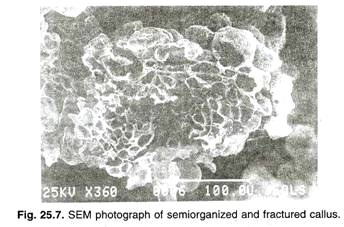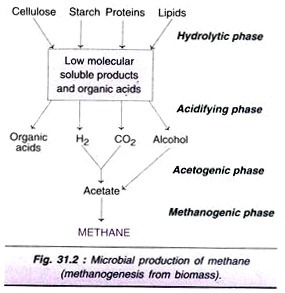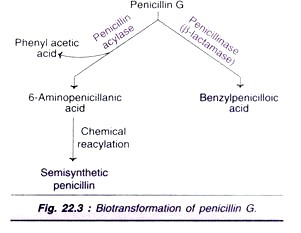ADVERTISEMENTS:
Read this article to learn about the techniques used for isolating genes from any organism for synthesis of naturally occurring proteins.
Site-Directed Mutagenesis:
With the advances in genetic engineering, genes can be isolated (from any organism) and used for the synthesis of naturally occurring proteins. Some of these proteins serve as enzymes (i.e., biocatalysts), and a selected few of them have industrial applications. Thus, of the 2000 natural enzymes, around 20 are used in food, and pharmaceutical industries e.g., a-amylase, cellulase, papain. The industrial enzymes enjoy a special status in biotechnology.
The natural enzymes are not well suited for industrial applications due to unnatural and un-physiological environments such as high temperature, unsuitable pH, the presence of certain chemicals (organic solvents) etc. Many attempts are made to improve the efficiency of natural enzymes for industrial use e.g., immobilization, chemical modifications. But these have very limited impact.
Strategies to Improve In Vitro Activities of Enzymes:
ADVERTISEMENTS:
Several possibilities can be thought of to improve the in vitro activities of the enzymes.
Some of them are listed below:
i. Increasing substrate affinity to enzyme.
ii. Making the enzyme thermal tolerant (active at high temperature) and/or pH stable.
ADVERTISEMENTS:
iii. Enhancing the substrate specificity by modifying the substrate binding site of the enzyme.
iv. Designing the enzyme to make it resistant to proteolytic degradation.
v. Synthesizing enzyme that is stable and active in non-aqueous solvents.
vi. Changing the enzyme in order to make it independent of cofactor(s) for its function.
vii. Eliminating allosteric sites in the enzyme so that it is not controlled by feedback inhibition.
viii. Improving the stability of the enzyme to heavy metals.
ix. Fusing the enzymes (making a multi-enzyme complex) needed in the reactions to give a final product.
Although the above possibilities appear to be more theoretical than practical, some achievements have been made for more efficient use of industrial enzymes. By subjecting the proteins to chemical modifications, suitable changes can be made in enzyme activity. Chemical manipulation of enzymes are non-specific, harsh and should be done repeatedly, hence not preferred.
Modifications in the DNA sequence of a gene are ideal to create a protein with desired properties. Site-directed mutagenesis is the technique for generating amino acid coding changes in the DMA (gene). By this approach specific (site-directed) change (mutagenesis) can be made in the base (or bases) of the gene to produce a desired enzyme.
ADVERTISEMENTS:
The net result in site-directed mutagenesis is incorporation of a desired amino acid (of one’s choice) in place of a specific amino acid in a protein or a polypeptide. By employing this technique, enzymes that are more efficient and more suitable than the naturally occurring counterparts can be created for industrial applications. But it must be remembered that site- directed mutagenesis is a trial and error method that may or may not result in a better protein.
Further, the detailed information on the structure and functions of a protein are desirable to undertake site-directed mutagenesis. It is customary to give emphasis for the creation of enzymes by this technique because of their commercial value through industrial use. The fact is that any naturally occurring protein with improved functions can be synthesized by site-directed mutagenesis. There are many methods employing site-directed mutagenesis. A selected few of them are briefly described.
Oligonucleotide-Directed Mutagenesis:
In the technique of oligonucleotide-directed mutagenesis, the primer is a chemically synthesized oligonucleotide (7-20 nucleotides long). It is complementary to a position of a gene around the site to be mutated. But it contains mismatch for the base to be mutated.
The basic technique is depicted in Fig. 10.1. The starting material is a single-stranded DNA (to be mutated) carried in an M13 phage vector. On mixing this DNA with primer, the oligonucleotide hybridizes with the complementary sequences, except at the point of mismatched nucleotide. Hybridization (despite a single base mismatch) is possible by mixing at low temperature with excess of primer, and in the presence of high salt concentration.
By the addition of 4-deoxyribonucleoside triphosphates and DNA polymerase (usually Klenow fragment of E.coli DNA polymerase) replication occurs. Thus the oligonucleotide primer is extended to form a complementary strand of the DNA. The ends of the newly synthesized DNA are sealed by the enzyme DNA ligase.
The double- stranded DNA (i.e., M13 phage molecule) containing the mismatched nucleotides is introduced into E. coli by transformation. The infected E. coli cells produce M13 virus particles containing either the original wild type sequence or the mutant sequence. The virus particles lyse the cells and form plaques.
Theoretically, it is expected that half of the phage M13 particles should carry wild, type sequence while the other half mutant sequence (since the DNA replicates semi conservatively). But in actual practice, due to technical reasons, only 1-5% of the viruses with mutated sequences are recovered.
The double-stranded DNAs of M13 are isolated. The mutated genes are cut with restriction enzymes, ligated to a plasmid vector of E. coli. The altered protein is produced in the E. coli which can be isolated and purified. Oligonucleotide-directed mutagenesis by using plasmid DNA (instead of M13) is also in use. This technique reduces the number of steps since mutagenesis and cloning the target DNA are in the same vector.
ADVERTISEMENTS:
Variations in oligonucleotide-directed mutagenesis:
There are some variations in use in the oligonucleotide-directed mutagenesis, as the situation demands.
1. Multiple point mutagenesis:
Oligonucleotide-directed mutagenesis can be used to create DNAs with multiple point mutations with the requisite number of base mismatches (Fig. 10.2A).
2. Insertion mutagenesis:
In this case, the mutant oligonucleotide carries a sequence to be inserted (sandwiched between two sites with complementary sequences). This can bind with the target DNA on either side (Fig. 10.2B).
3. Deletion mutagenesis:
The mutant oligonucleotide binds to two separate sites on either side of the target DNA. This enables a small position of target DNA to be deleted (Fig. 10.2C).
Casettee Mutagenesis:
In casettee mutagenesis, a synthetic double- stranded oligonucleotide (a small DNA fragment i.e., casettee) containing the requisite/desired mutant sequence is used. It replaces the corresponding sequence in the wild type DNA. Casettee mutagenesis is possible if the fragment of the gene to be mutated lies between two restriction enzyme cleavage sites. This intervening sequence can be cut and replaced by the synthetic oligonucleotide (with mutation).
The outline of the casettee mutagenesis technique is depicted in Fig. 10.3. The plasmid DNA is cut with restriction enzymes (such as EcoRI and Hindi 11). The synthetic oligonucleotide containing mutant sequence is also cleaved and ligated to plasmid DNA. The recombinant plasmids that multiply in E. coli are all mutants.
Casettee mutagenesis is a simple technique with almost 100% efficiency to get mutant genes. The drawback is the requirement of restriction sites specifically flanking the target fragment of DNA and the limitation to get desired oligonucleotides.
PCR-Amplified Oligonucleotide-Directed Mutagenesis:
The PCR technique can be used in oligonucleotide- directed mutagenesis. This avoids the use of a bacteriophage (M13) system, besides enrichment of mutated gene. The PCR-based mutagenesis technique commonly employed is depicted in Fig. 10.4. First the target DNA (gene) is cloned on to a plasmid vector and distributed into two reaction tubes.
To each tube are added two primers (oligonucleotides synthesized by using PCR). One primer (A in tube 1 and C in tube 2) is complementary to a region in one strand of the cloned gene except for one nucleotide mismatch (i.e., the one targeted for a change).
The other primer (B in tube 1 and D in tube 2) is fully complementary to a sequence in the other strand, within or adjacent to the cloned gene. The placement of primers for hybridization (with the DNA strands) in each tube is done in opposite direction. Now, the PCR technique is carried out for amplification of the DNA molecules. These DNAs are actually linear. In Fig. 10.4, they are shown as discontinuous circles for understanding subsequent steps.
The products of PCR in the two reaction tubes are mixed. The DNA molecules undergo denaturation and renaturation. A strand from one reaction tube (strand A) hybridizes with its complementary strand from other reaction tube (strand C). They form circles with nicks (gaps). The circular plasmids (containing mutant DNA) with nicks are introduced into E. coli by transformation. The nicks are sealed in vivo by host cell enzymes and the plasmids are propagated indefinitely.




